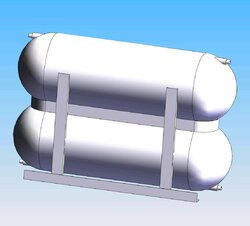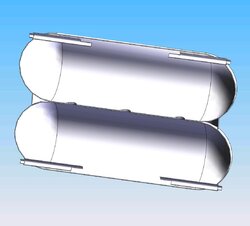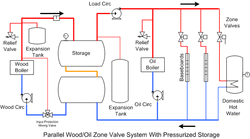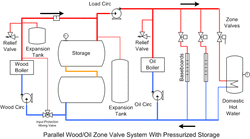In the year or so I've been following this forum I've had the privilege of using the expertise and pioneering experiments of others to lead me to design my own storage system for my Tarm Solo based heating system. I had gone through various unpressurized pool and copper coils plans when I ran into a couple 500 gallon propane tanks and sailed off into various pressurized storage schemes. How to connect the two tanks and where to put them in an existing basement with only 7 1/2' ceiling height?
Well, some of the pioneering being done on this side of the Atlantic is old news a few thousand miles northeast of here. There are so many schemes to switch boiler output from heating loads to storage and back I began to wonder if any of that was necessary. Why not just directly couple the boiler to the storage tank (this would only be practical for a pressurized storage tank) and take all the heat loads from the tank directly. Seems it is common in Northern Europe.
Seems to me the weakest feature of a directly coupled storage tank is when the tank is depleted of hot water and it's cold out there and you just got home from a weekend away... How long will it take to get hot water out of that tank and start heating the house and get some hot water for a good long soak in the tub? Do you have to heat up the whole tank first? Hydraulic seperators do this quickly by being narrow vertical tanks with a short distance between the hot water in and the hot water out ports so the boiler supply water flows the short distance across and is drawn into the heating circuits by the pumps feeding the heating loads. How to do that with horizontal tanks 10 ft. long? And how to put 2 of these tanks together to get 1000 gallons?
Well, here is my latest scheme and I have the materials and started cutting and fitting. At some point you have to stop tweaking designs and start gettin' 'er done. I have use of world class welding facilities (and welder, not me) where I work so weld quality will not be an issue.
Boiler supply comes into the tank at the top left and goes back to the boiler bottom left. The hot water to the heating loads goes out top right and cooler return water comes back into the tank bottom right. My expectation is that once the boiler supply water starts flowing out of the boiler it will only take a few minutes before that hot water will float across and be available to the heating loads at the opposite end of the tank. There is only a few feet between the pipes in the tank and I have enough of that big 3" pipe to put them even closer if I get worried.
I would appreciate any input from you folks out there because there has to be at least a couple things I haven't fretted over yet and I haven't welded anything yet.
So let's see if my first attempt at photos works.
Well, some of the pioneering being done on this side of the Atlantic is old news a few thousand miles northeast of here. There are so many schemes to switch boiler output from heating loads to storage and back I began to wonder if any of that was necessary. Why not just directly couple the boiler to the storage tank (this would only be practical for a pressurized storage tank) and take all the heat loads from the tank directly. Seems it is common in Northern Europe.
Seems to me the weakest feature of a directly coupled storage tank is when the tank is depleted of hot water and it's cold out there and you just got home from a weekend away... How long will it take to get hot water out of that tank and start heating the house and get some hot water for a good long soak in the tub? Do you have to heat up the whole tank first? Hydraulic seperators do this quickly by being narrow vertical tanks with a short distance between the hot water in and the hot water out ports so the boiler supply water flows the short distance across and is drawn into the heating circuits by the pumps feeding the heating loads. How to do that with horizontal tanks 10 ft. long? And how to put 2 of these tanks together to get 1000 gallons?
Well, here is my latest scheme and I have the materials and started cutting and fitting. At some point you have to stop tweaking designs and start gettin' 'er done. I have use of world class welding facilities (and welder, not me) where I work so weld quality will not be an issue.
Boiler supply comes into the tank at the top left and goes back to the boiler bottom left. The hot water to the heating loads goes out top right and cooler return water comes back into the tank bottom right. My expectation is that once the boiler supply water starts flowing out of the boiler it will only take a few minutes before that hot water will float across and be available to the heating loads at the opposite end of the tank. There is only a few feet between the pipes in the tank and I have enough of that big 3" pipe to put them even closer if I get worried.
I would appreciate any input from you folks out there because there has to be at least a couple things I haven't fretted over yet and I haven't welded anything yet.
So let's see if my first attempt at photos works.





